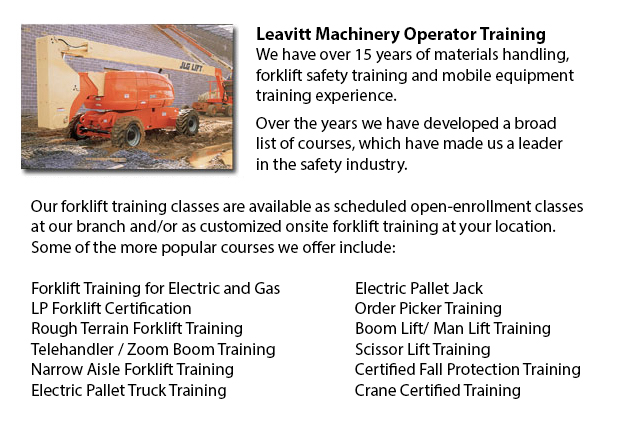
Aerial Lift Safety Training Fort Mcmurray - There are about 26 to 30 construction fatalities in North America attributed to the utilization of aerial lifts. Nearly all of those killed are craftsmen like for instance electrical workers, laborers, painters, carpenters or ironworkers. The majority of the fatalities are caused by falls, tip-overs and electrocutions. The greatest risk is from boom-supported lifts, like for example bucket trucks and cherry pickers. The majority of the fatalities are related to this particular kind of lift, with the rest involving scissor lifts. Other risks include being struck by falling things, being thrown out of a bucket, and being caught between the guardrail or lift bucket and an object, such as a joist or steel beam.
To safely operate an aerial lift, carry out an inspection on the following items prior to utilizing the device: emergency and operating controls, safety devices (like for example, outriggers and guardrails), personal fall protection gear, and wheels and tires. Look for possible leaks in the air, hydraulic fluid and fuel-system. Inspect the device for loose or missing parts.
The places where worker would utilize the aerial device should be examined thoroughly for potential dangers, such as bumps, holes, debris and drop-offs. Overhead powerlines need to be monitored and avoided. It is suggested that aerial lift devices be used on stable, level surfaces. Do not work on steep slopes which exceed slope limits which the manufacturer specified. Even on a slope which is level, brakes, wheel chocks and outriggers should be set.
Businesses must provide their aerial lift operators with the correct guidebooks. Mechanics and operators should be trained by a qualified person experienced with the relevant aerial lift model.
Aerial Lift Safety Tips:
o Close lift platform chains or doors prior to operating.
o Leaning over and climbing on guardrails is prohibited. Stand on the floor of the bucket or platform.
o Use the provided manufacturer's load-capacity restrictions.
o When working near traffic, use appropriate work-zone warnings, like for instance cones and signs.
If proper procedures are followed, electrocutions are preventable. Stay at least ten feet away from whichever power lines and licensed electricians must de-energize and/or insulate power lines. Individuals working have to utilize personal protective equipment and tools, such as insulated bucket. Then again, a bucket that is insulated does not protect from electrocution if, for example, the worker touches another wire providing a path to the ground.
When in the bucket, workers must prevent possible falls by securing themselves to the guardrails by using a positioning device or a full-body harness. If there is an anchorage within the bucket, a positioning belt together with a short lanyard is acceptable.
By following the manufacturer's instructions, tip-overs could be avoided. Never drive the lift platform when it is elevated, unless the manufacturer specifies otherwise. Adhere to the device's vertical and horizontal reach limits, and never exceed the load-capacity which is specified.
-
Telehandler Training Fort Mcmurray
Telehandler Training Fort Mcmurray - Telehandlers or also called Telescopic handlers are very popular piece of heavy construction equipment most often utilized in agriculture and construction industries. These machines have extreme reaching capabilit... More -
Counterbalance Forklift Training Fort Mcmurray
Counterbalance Forklift Training Fort Mcmurray - Counterbalance Forklift Training courses are always in high demand. The Counterbalance forklift is a forklift that is made along with a weight that counters the balance, evenly spreading the weight of... More -
Heavy Equipment Training School Fort Mcmurray
Heavy Equipment Training School Fort Mcmurray - HEO or the heavy equipment operator courses will provide you with the knowledge and skills required in order to enter the workforce as an entry level heavy machine operator. In this 12 week course in ad... More -
Operator Safety Training, Re-Qualification Training, In-House Instructor Training in Fort McMurray
Used in just about all boat yards, industrial construction sites or warehouse operations, the forklift is a very important component in order to help pick up and transfer supplies. The reach feature of a lift truck could help improve the applications... More -
Heavy Equipment License Fort Mcmurray
Heavy Equipment License Fort Mcmurray - A heavy equipment license can be obtained by finishing a certification and preparation course at a private training school or a vocational school. This license would qualify you to operate various types of heav... More -
Boom Lift License Fort Mcmurray
Boom Lift License Fort Mcmurray - To operate an aerial boom lift, operators must be licensed through training that can be obtained utilizing both practical training and classroom sessions and by obtaining a boom lift license. Instruction must be give... More -
Skid Steer Loader Training in Fort McMurray
A skid-steer loader is actually an engine powered machine that consists of a small and rigid frame. It is outfitted along with lift arms which are used to attach to different labor saving attachments and tools. Normally, skid-steer loaders are four-w... More -
Order Picker Ticket Fort Mcmurray
Order Picker Ticket Fort Mcmurray - Order picker's enables warehouse employees to lift pallets using forks. Likewise called a stock picker, this electrically-powered equipment is like a forklift except that an order picker is likewise utilized to lif... More

Forklift Training Fort McMurray
TOLL FREE: 1-888-254-6157
Fort McMurray, Alberta
forklifttrainingfortmcmurray.com
Email Us
About Us


